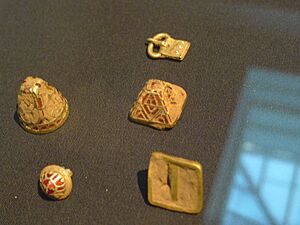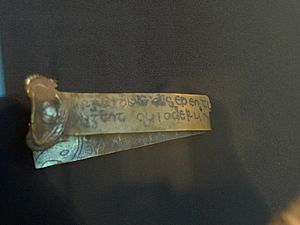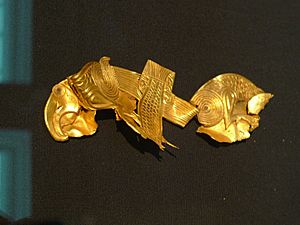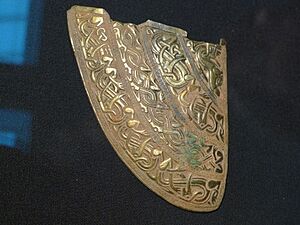Staffordshire Hoard facts for kids
Quick facts for kids Staffordshire Hoard |
|
|---|---|
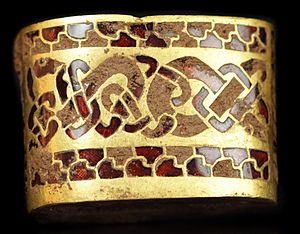 |
|
| Material |
|
| Size | over 3,500 items |
| Writing | Latin |
| Created | c. 7th to 8th centuries |
| Discovered | 2009 Hammerwich near Lichfield, Staffordshire, England 52°39′19″N 1°54′24″W / 52.65528°N 1.90667°W |
| Discovered by | Terry Herbert |
| Present location | |
The Staffordshire Hoard is the largest collection of Anglo-Saxon gold and silver objects ever found. It was discovered in 2009 in a field in Staffordshire, England. This amazing treasure includes over 3,500 items. These items weigh about 5.1 kilograms (11.2 pounds) of gold and 1.4 kilograms (3.1 pounds) of silver. There are also about 3,500 pieces of garnet cloisonné jewellery.
Experts believe the hoard was buried in the 7th century. The items themselves were likely made during the 6th and 7th centuries. At the time it was buried, the area was part of the Anglo-Saxon kingdom of Mercia.
This discovery is super important for understanding Anglo-Saxon archaeology. Most of the items are related to war, like parts of swords and a helmet. There are no objects that were typically used by women. The craftsmanship of these pieces is incredibly high, especially considering how many individual items were found.
The hoard was bought by the Birmingham Museum and Art Gallery and the Potteries Museum & Art Gallery. They paid £3.285 million for it. This purchase happened under the Treasure Act 1996, which helps protect important finds.
Contents
What's in the Staffordshire Hoard?
The hoard contains 3,490 metal pieces. This includes over 5 kilograms of gold and 1.4 kilograms of silver. There are also 3,500 garnets set in metal. It's the biggest Anglo-Saxon gold and silver treasure found so far. It's even larger than the 1.5-kilogram hoard found in the famous Sutton Hoo ship burial in 1939.
Most of the items in the hoard are military, meaning they relate to war. There are only a few religious objects. You won't find everyday items like bowls or eating tools. There's also no jewelry typically worn by women. It seems like the items were carefully chosen before they were buried.
Most experts agree that the typical object in the hoard was made in the 7th century. The hoard was buried sometime after the newest object in it was created. Studies of the hoard showed that Saxon goldsmiths could change the surface of gold. They used a technique called depletion gilding to make the gold look purer. This skill was not known before this discovery. Like other Anglo-Saxon jewelry, some garnets in the hoard might have come from far away. They could have traveled from places like Sri Lanka or Afghanistan during the Roman period.
Weapon Parts and Decorations
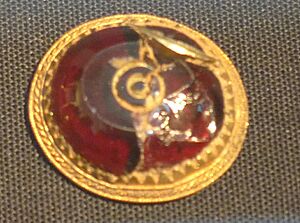
The hoard has many beautifully made silver and gold decorations from weapons. This includes 66 gold sword hilt collars. There are also many gold hilt plates. Some of these plates have inlays of cloisonné garnet with animal-like designs.
The 86 sword pommels found are the largest collection of pommels ever discovered at one time. There are many different types, some never seen before. This suggests that these pommels were made over a long period.
Christian Crosses
The official statements about the Staffordshire Hoard mention that only two (or possibly three) items are clearly not military. These are crosses. Some experts believe there might be even more Christian items in the hoard. The largest of the three crosses is missing some decorations. However, it is mostly still in one piece. It might have been an altar or processional cross. It could also have been attached to the front of a book, like a Gospel Book.
Interestingly, this cross is folded. There are a few ideas why it was folded. One idea is that it was folded to fit into a small space before burial. Another idea is that it was buried by pagans who didn't respect Christian objects. A third idea is the opposite: Christians folded it with respect. They might have done this to remove its sacred meaning before burying it. A gold and garnet fitting, made for the corner of a flat object, might have been for a book cover. If so, it was almost certainly a Gospel Book.
The Gold Strip with Writing
One of the most interesting items is a small gold strip (StH 550). When unfolded, it measures about 17.9 centimeters (7 inches) long. It has a Bible quote from Numbers 10:35 written on both sides in insular majuscule script.
The quote says: "Rise up, Lord, and let your enemies be scattered; and let those who hate you flee from your face."
The extra words on the second side are unclear. They might be practice letters. This would mean that the inside face was not meant to be seen. The passage is often quoted, for example, in the Life of the Mercian Saint Guthlac. This book was written around the 730s. The gold strip might have been attached to a shield or a sword belt. It could also have been part of the arm of a cross.
Why was the Hoard buried?
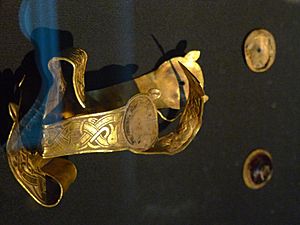
The hoard was buried in a quiet area, south of the old Roman road called Watling Street. This spot was in the kingdom of Mercia. The quality of the items in the hoard is very high. The fact that most items are related to war, especially sword decorations, suggests it wasn't just random loot. Most of the gold and silver pieces seem to have been carefully removed from the objects they were once part of.
Some experts believe the warlike nature of the items is linked to a custom. This custom involved giving war-gear (heriot) to the king when a nobleman died. Removing sword pommel caps is even mentioned in the old poem Beowulf. In the poem, warriors strip the pommels from their enemies' swords.
Some theories connect the hoard to specific historical events. One idea links it to Peada, who was briefly king of Mercia around 655-656. Another idea suggests the hoard was buried because of a Viking attack on Lichfield in 875.
How the Hoard was Found
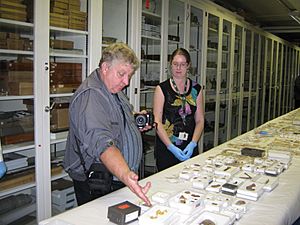
Terry Herbert found the first gold items on July 5, 2009. He was using a metal detector in a recently plowed field near Hammerwich, Staffordshire. Over the next five days, 244 gold objects were found in the soil. Terry then contacted Duncan Slarke, a local expert on ancient finds. The landowner, Fred Johnson, gave permission for archaeologists to search for more of the hoard.
The First Dig (2009)
English Heritage paid for the excavation work. They hired Birmingham Archaeology to do the digging. The items had been spread out by plowing, so a large area was searched. Because the find was so important, the exact location was kept secret at first. A special survey of the field found what might be a ditch near the discovery. More investigation is planned for this. In total, over 3,500 pieces were found. A final survey using special equipment confirmed no more items remained.
The discovery was announced to the public on September 24, 2009. It quickly gained worldwide attention. An official website about the hoard received over 10 million views in its first week. While the archaeologists worked on the find, some items were shown at the Birmingham Museum and Art Gallery. About 40,000 people came to see them. The local coroner declared the hoard to be treasure. This meant it belonged to the Crown (the government). More pieces were shown at the Potteries Museum & Art Gallery in Stoke-on-Trent. Key items were then taken to the British Museum in London for cleaning and study.
By September 24, 2009, 1,381 objects had been recovered. Many were very small. X-rays of unexamined soil lumps suggested more items were hidden inside. Early studies showed that the hoard was not buried with a body.
More Finds in 2012
In December 2012, it was announced that 91 more gold and silver items had been found. These were discovered in the same field where the hoard was found in 2009. The new finds happened in November 2012 after the field had been plowed again. Archaeologists and metal detectorists from Archaeology Warwickshire made the discovery.
Many of these new pieces weigh less than 1 gram. But there are also some larger items. These include a cross-shaped mount, an eagle-shaped mount, and a helmet cheek piece. This cheek piece matches one from the 2009 discovery. Experts believe these new pieces are part of the original hoard.
In January 2013, 81 of the 91 items were officially declared treasure. Once they are valued, Staffordshire County Council will have a chance to buy them. This way, they can be reunited with the rest of the hoard. Even though archaeologists found these items, the money from their sale will be shared. It will go to Terry Herbert and Fred Johnson, who made the original discovery. The ten items not declared treasure were identified as modern waste.
Kevin Leahy from the British Museum said that the ten items not part of the original hoard might be from a different Anglo-Saxon collection. Two of these ten items are high-quality copper alloy pieces. However, they look different from the gold and silver items of the main hoard. He thinks that Anglo-Saxons might have visited the site more than once to bury items.



